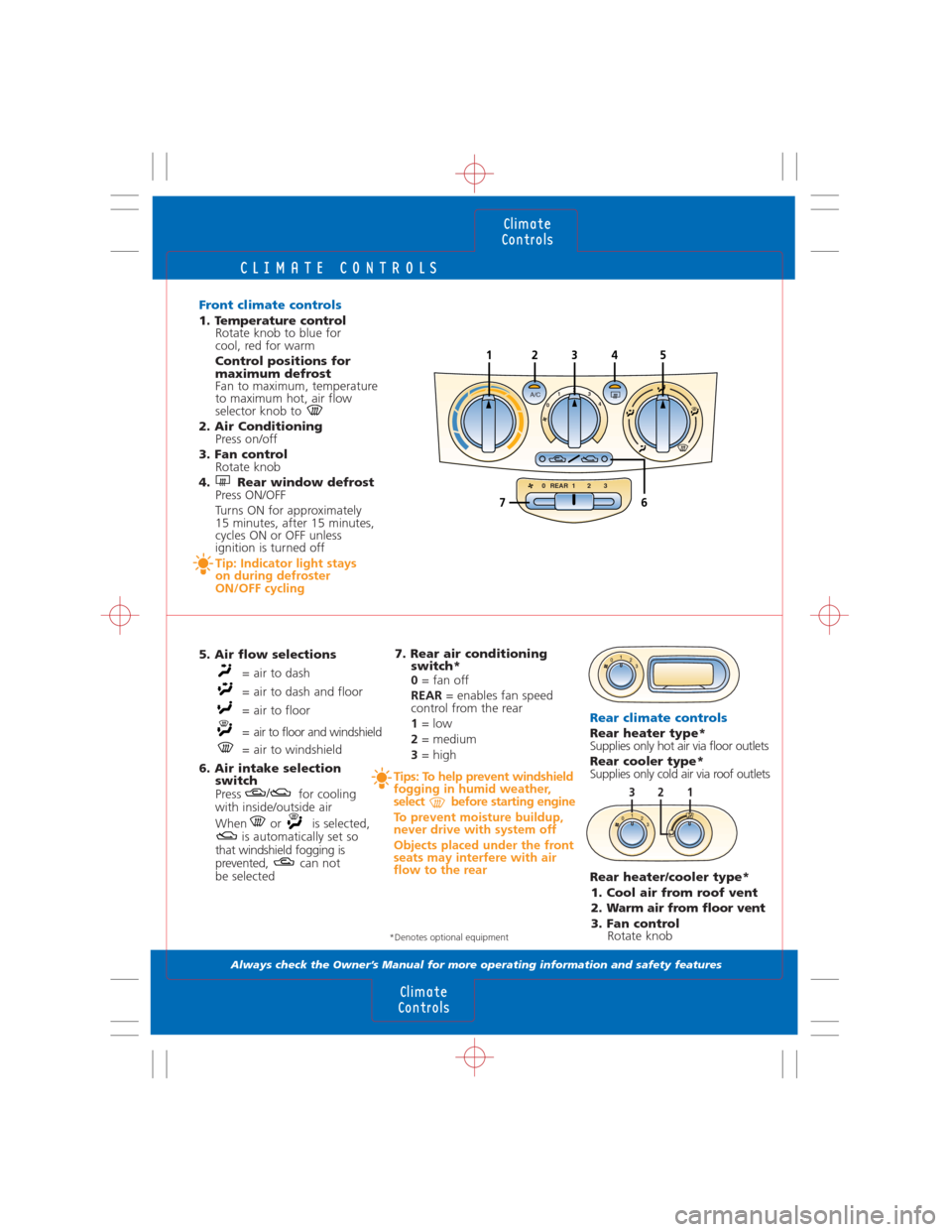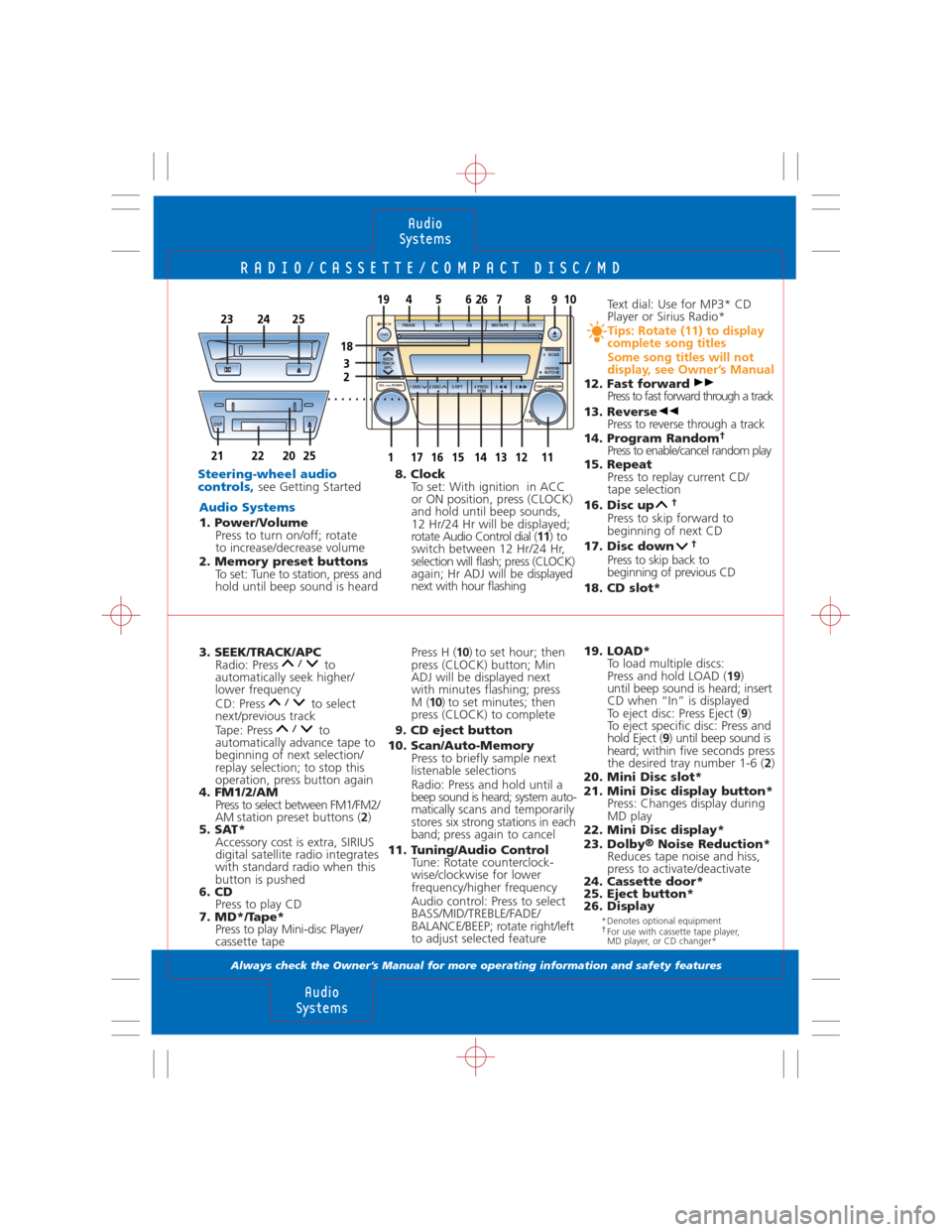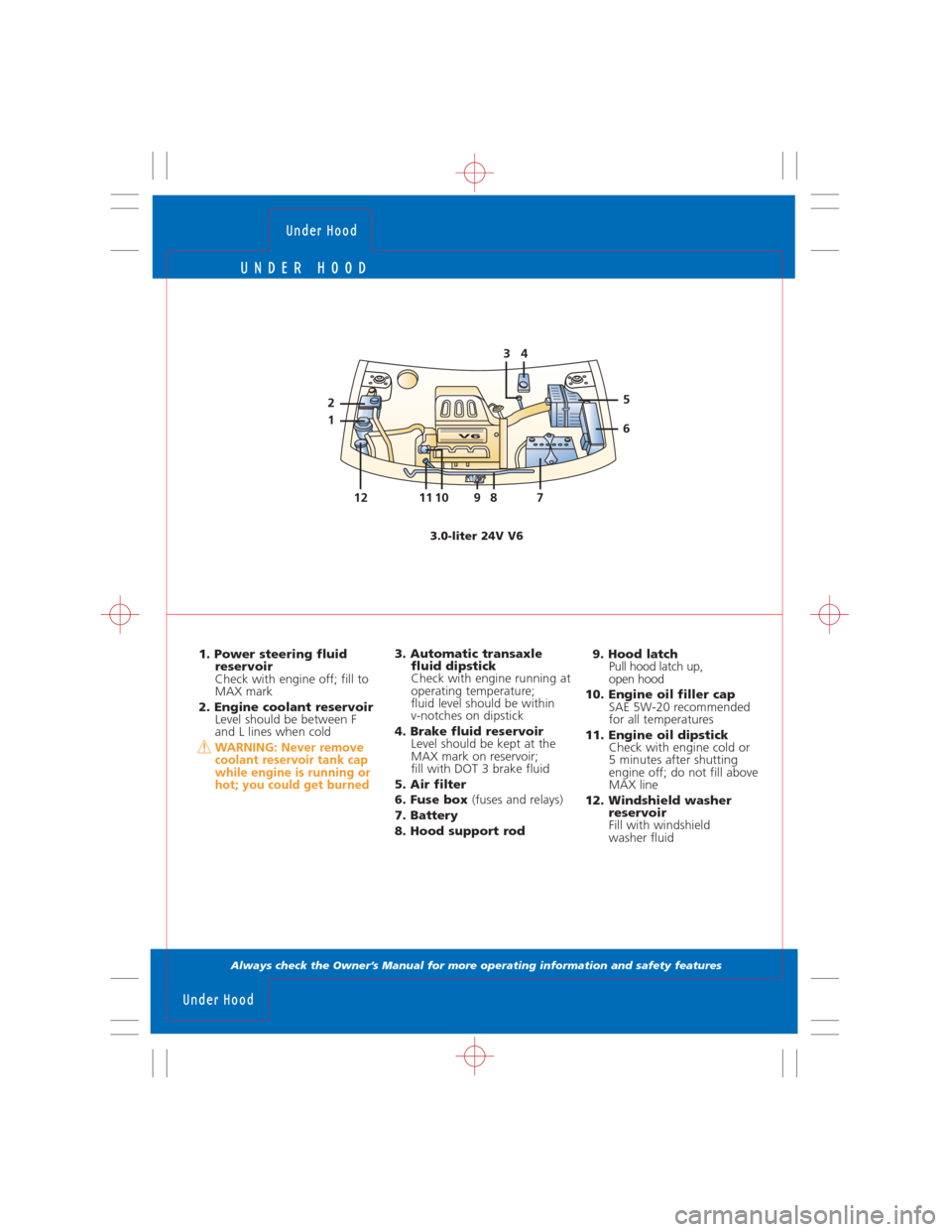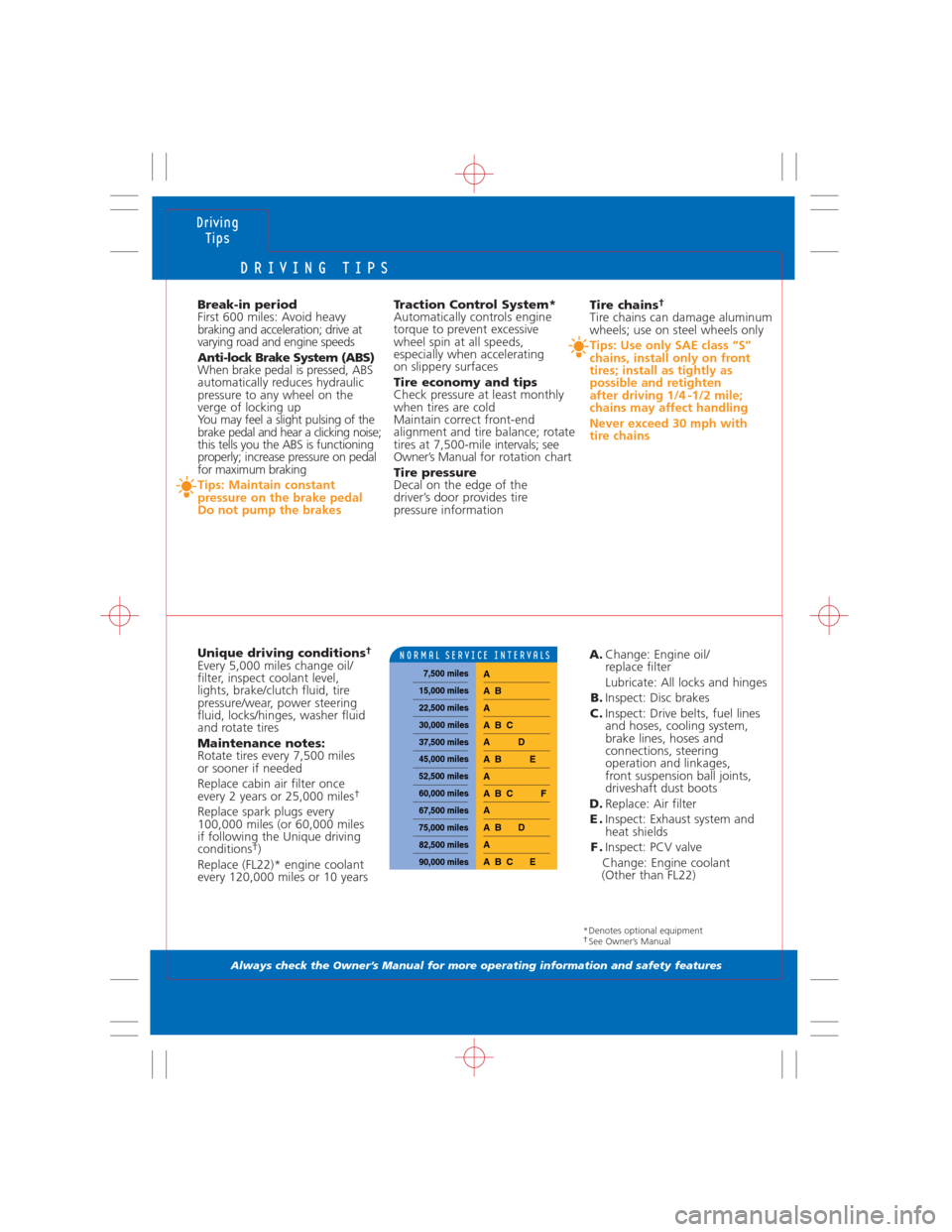MAZDA MODEL MPV 2006 Quick Tips (in English)
Manufacturer: MAZDA, Model Year: 2006, Model line: MODEL MPV, Model: MAZDA MODEL MPV 2006Pages: 14, PDF Size: 1.07 MB
Page 11 of 14

CLIMATE CONTROLS
Always check the Owner’s Manual for more operating information and safety features
Climate
Controls
Climate
Controls
Rear climate controlsRear heater type*
Supplies only hot air via floor outlets
Rear cooler type*
Supplies only cold air via roof outlets
Front climate controls1. Temperature control
Rotate knob to blue for
cool, red for warm
Control positions for
maximum defrost
Fan to maximum, temperature
to maximum hot, air flow
selector knob to
2. Air Conditioning
Press on/off
3. Fan control
Rotate knob
4. Rear window defrost
Press ON/OFF
Turns ON for approximately
15 minutes, after 15 minutes,
cycles ON or OFF unless
ignition is turned off
Tip: Indicator light stays
on during defroster
ON/OFF cycling
7. Rear air conditioning
switch*
0= fan off
REAR = enables fan speed
control from the rear
1= low
2= medium
3= high
Tips: To help prevent windshield
fogging in humid weather,
select before starting engine
To prevent moisture buildup,
never drive with system off
Objects placed under the front
seats may interfere with air
flow to the rear
5. Air flow selections
= air to dash
= air to dash and floor
= air to floor
= air to floor and windshield
= air to windshield
6. Air intake selection
switch
Press for cooling
with inside/outside air
When or is selected,
is automatically set so
that windshield fogging is
prevented,can not
be selected
/
0
0123REAR
12
3
4A/C
15342
6
7
132
Rear heater/cooler type*
1. Cool air from roof vent
2. Warm air from floor vent
3. Fan control
Rotate knob
*Denotes optional equipment
Page 12 of 14

RADIO/CASSETTE/COMPACT DISC/MD
Always check the Owner’s Manual for more operating information and safety features
Audio
Systems
Audio
Systems
3. SEEK/TRACK/APC
Radio: Press to
automatically seek higher/
lower frequency
CD: Press to select
next/previous track
Tape: Press to
automatically advance tape to
beginning of next selection/
replay selection; to stop this
operation, press button again
4. FM1/2/AM
Press to select between FM1/FM2/
AM station preset buttons (2)
5. SAT*
Accessory cost is extra, SIRIUS
digital satellite radio integrates
with standard radio when this
button is pushed
6. CD
Press to play CD
7. MD*/Tape*
Press to play Mini-disc Player/
cassette tape
Steering-wheel audio
controls,see Getting Started
Audio Systems1. Power/Volume
Press to turn on/off; rotate
to increase/decrease volume
2. Memory preset buttons
To set: Tune to station, press and
hold until beep sound is heard
Press H (10) to set hour; then
press (CLOCK) button; Min
ADJ will be displayed next
with minutes flashing; press
M (10) to set minutes; then
press (CLOCK) to complete
9. CD eject button
10. Scan/Auto-Memory
Press to briefly sample next
listenable selections
Radio: Press and hold until a
beep sound is heard; system auto-
maticallyscans and temporarily
stores six strong stations in each
band; press again to cancel
11. Tuning/Audio Control
Tune: Rotate counterclock-
wise/clockwise for lower
frequency/higher frequency
Audio control: Press to select
BASS/MID/TREBLE/FADE/
BALANCE/BEEP; rotate right/left
to adjust selected feature 8. Clock
To set: With ignition in ACC
or ON position, press (CLOCK)
and hold until beep sounds,
12 Hr/24 Hr will be displayed;
rotate Audio Control dial (11)to
switch between 12 Hr/24 Hr,
selection will flash; press (CLOCK)
again; Hr ADJ will be displayed
next with hour flashing
19. LOAD*
To load multiple discs:
Press and hold LOAD (19)
until beep sound is heard; insert
CD when “In” is displayed
To eject disc: Press Eject (9)
To eject specific disc: Press and
hold Eject (9) until beep sound is
heard;within five seconds press
the desired tray number 1-6 (2)
20. Mini Disc slot*
21. Mini Disc display button*
Press: Changes display during
MD play
22. Mini Disc display*
23. Dolby
®Noise Reduction*
Reduces tape noise and hiss,
press to activate/deactivate
24. Cassette door*
25. Eject button*
26. DisplayText dial: Use for MP3* CD
Player or Sirius Radio*
Tips: Rotate (11) to display
complete song titles
Some song titles will not
display, see Owner’s Manual
12. Fast forward
Press to fast forward through a track
13. Reverse
Press to reverse through a track
14. Program Random
†Press to enable/cancel random play
15. Repeat
Press to replay current CD/
tape selection
16. Disc up
†
Press to skip forward to
beginning of next CD
17. Disc down
†
Press to skip back to
beginning of previous CD
18. CD slot*
SEEK
TRACK
APC
1 DISC 2 DISC 3 RPT 4 PROG
RDM56 FM/AM SAT CD MD/TAPE
TEXT CLOCKH SCAN
M AUTO-MDISP/ESN
DSP
. . . . . . . . . . . . .
141517131612111
232425
4567810
32
DISC INLOAD
TUNE PUSH AUDIO CONT VOL PUSH POWER
1826
25222120
199
*Denotes optional equipment†For use with cassette tape player,
MD player, or CD changer*
Page 13 of 14

UNDER HOOD
Always check the Owner’s Manual for more operating information and safety features
Under Hood
1. Power steering fluid
reservoir
Check with engine off; fill to
MAX mark
2. Engine coolant reservoir
Level should be between F
and L lines when cold
WARNING: Never remove
coolant reservoir tank cap
while engine is running or
hot; you could get burned
3. Automatic transaxle
fluid dipstick
Check with engine running at
operating temperature;
fluid level should be within
v-notches on dipstick
4. Brake fluid reservoir
Level should be kept at the
MAX mark on reservoir;
fill with DOT 3 brake fluid
5. Air filter
6. Fuse box (fuses and relays)
7. Battery
8. Hood support rod9. Hood latch
Pull hood latch up,
open hood
10. Engine oil filler cap
SAE 5W-20 recommended
for all temperatures
11. Engine oil dipstick
Check with engine cold or
5 minutes after shutting
engine off; do not fill above
MAX line
12. Windshield washer
reservoir
Fill with windshield
washer fluid
6
5
1298711
2
1
10
43
3.0-liter 24V V6
Under Hood
Page 14 of 14

DRIVING TIPS
Always check the Owner’s Manual for more operating information and safety features
Driving
Tips
Break-in period
First 600 miles: Avoid heavy
braking and acceleration; drive at
varying road and engine speeds
Anti-lock Brake System (ABS)
When brake pedal is pressed, ABS
automatically reduces hydraulic
pressure to any wheel on the
verge of locking up
You may feel a slight pulsing of the
brake pedal and hear a clicking noise;
this tells you the ABS is functioning
properly; increase pressure on pedal
for maximum braking
Tips: Maintain constant
pressure on the brake pedal
Do not pump the brakes
Unique driving conditions†
Every 5,000 miles change oil/
filter, inspect coolant level,
lights, brake/clutch fluid, tire
pressure/wear, power steering
fluid, locks/hinges, washer fluid
and rotate tires
Maintenance notes:
Rotate tires every 7,500 miles
or sooner if needed
Replace cabin air filter once
every 2 years or 25,000 miles
†
Replace spark plugs every
100,000 miles (or 60,000 miles
if following the Unique driving
conditions
†)
Replace (FL22)* engine coolant
every 120,000 miles or 10 yearsTraction Control System*
Automatically controls engine
torque to prevent excessive
wheel spin at all speeds,
especially when accelerating
on slippery surfaces
Tire economy and tips
Check pressure at least monthly
when tires are cold
Maintain correct front-end
alignment and tire balance; rotate
tires at 7,500-mile intervals; see
Owner’s Manual for rotation chart
Tire pressure
Decal on the edge of the
driver’s door provides tire
pressure information
A.Change: Engine oil/
replace filter
Lubricate: All locks and hinges
B.Inspect: Disc brakes
C.Inspect: Drive belts, fuel lines
and hoses, cooling system,
brake lines, hoses and
connections, steering
operation and linkages,
front suspension ball joints,
driveshaft dust boots
D.Replace: Air filter
E.Inspect: Exhaust system and
heat shields
F.Inspect: PCV valve
Change: Engine coolant
(Other than FL22) Tire chains
†Tire chains can damage aluminum
wheels; use on steel wheels only
Tips: Use only SAE class “S”
chains, install only on front
tires; install as tightly as
possible and retighten
after driving 1/4 -1/2 mile;
chains may affect handling
Never exceed 30 mph with
tire chains
*Denotes optional equipment†See Owner’s Manual
NORMAL SERVICE INTERVALS
7,500 miles
15,000 miles
22,500 miles
30,000 miles
37,500 miles
45,000 miles
52,500 miles
60,000 miles
67,500 miles
75,000 miles
82,500 miles
90,000 miles
A BC E A A B
D A A
B C F A
A B
E A D
A
BC A
A B
A